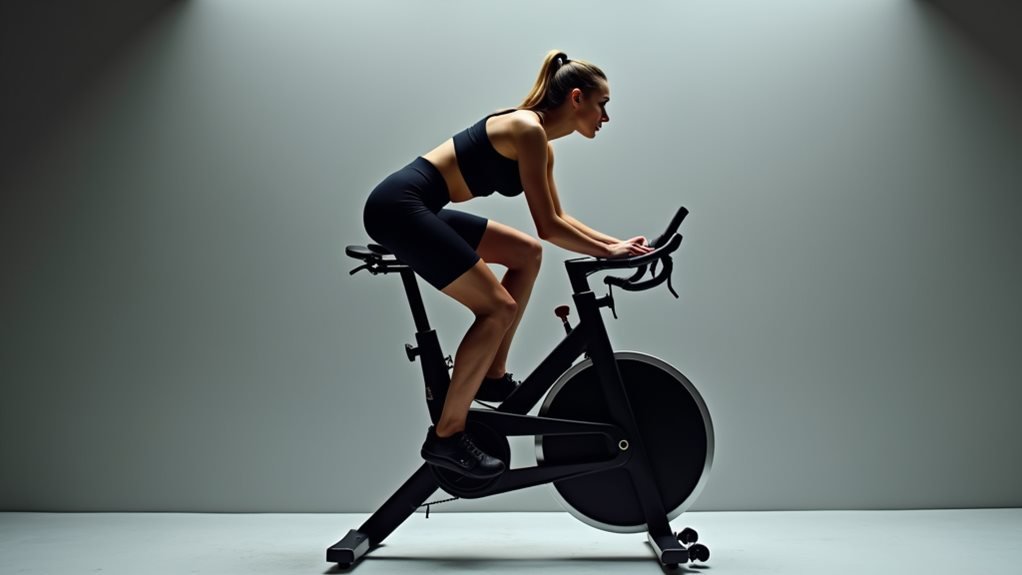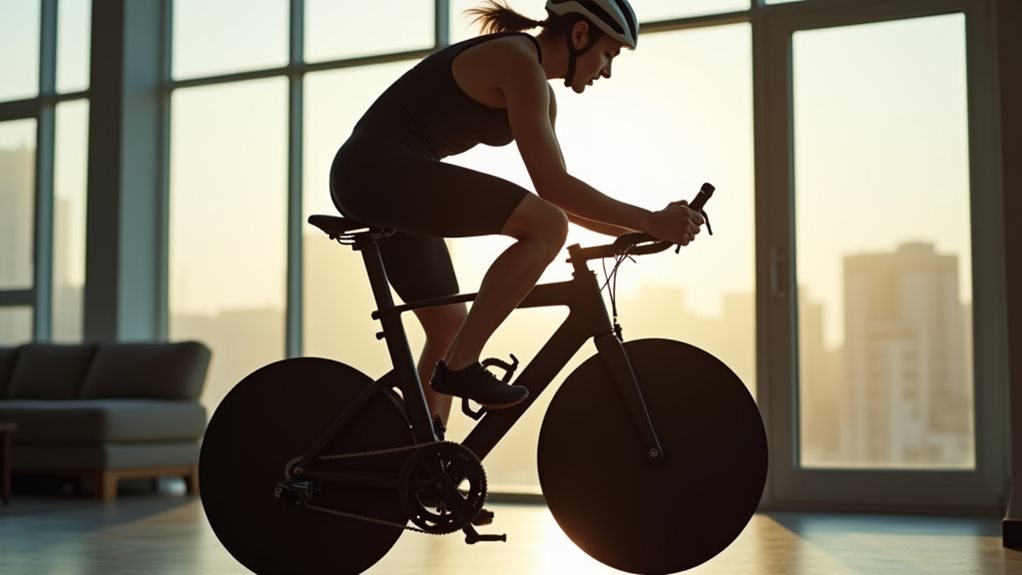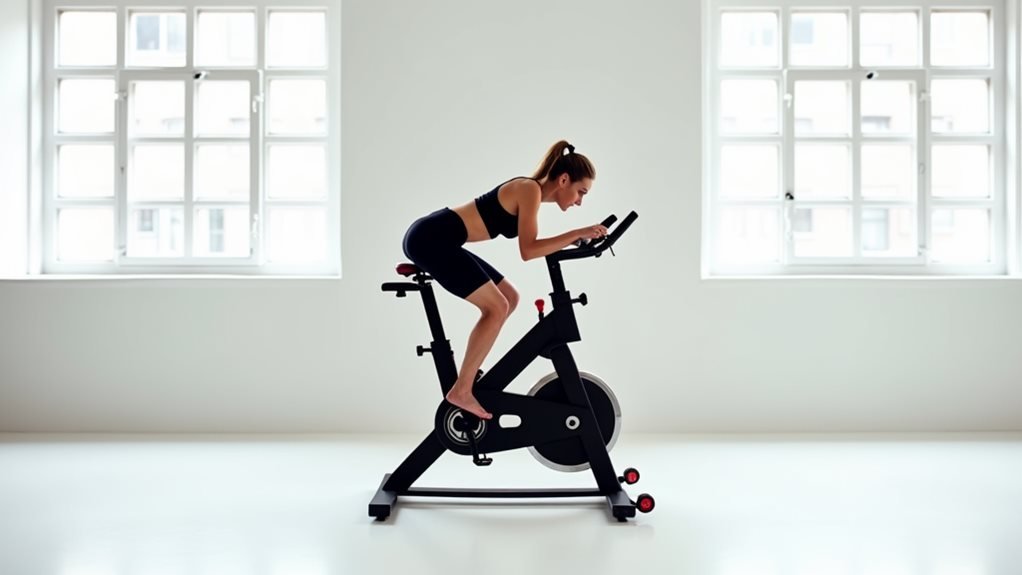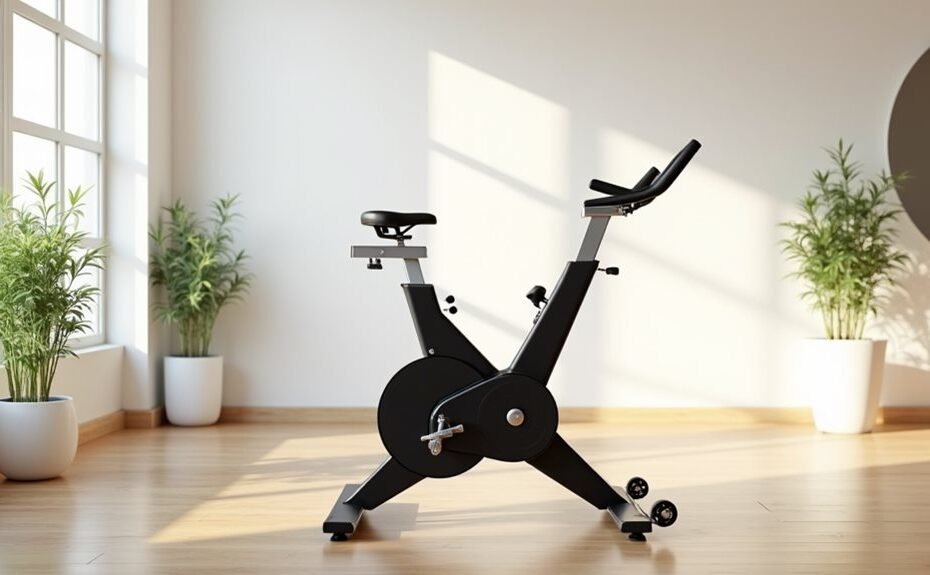When Sarah first stepped onto a stationary bike at her physical therapy clinic, she couldn't bend her knee past 90 degrees after surgery. Within eight weeks of guided joint mobility work, she'd regained full range of motion and returned to competitive cycling. I've seen countless examples of how stationary bikes can transform joint health, from relieving arthritis symptoms to rebuilding strength after injury. While most cyclists focus on power output and cardiovascular gains, I'll show you how the stationary bike can become your most powerful tool for accessing peak joint mobility and preventing future injuries.
Key Takeaways
- Maintain proper form with steady pelvis and foot positioning to maximize joint benefits while engaging multiple muscle groups effectively.
- Perform slow, controlled pedaling movements to enhance joint articulation and develop better range of motion throughout your workout.
- Integrate dynamic stretching before riding to warm up joints and prepare muscles for optimal mobility during exercise.
- Focus on circular pedaling motion to lubricate joints with synovial fluid while strengthening supporting muscles around them.
- Build endurance through consistent cadence while targeting hip mobility and lower trunk rotations for improved cycling performance.
Why Static Bikes Transform Joints
Anyone looking to protect their joints while staying active should consider static bikes. I'll tell you why: they're biomechanical masterpieces that transform joint health without beating up your body. Trust me, your knees will thank you for ditching those high-impact activities.
Let's get technical for a moment. Static bikes create a perfect storm of joint-friendly benefits. While you're pedaling away, your joints are bathing in synovial fluid – nature's own lubricant. It's like giving your joints an oil change with every session. Low-impact exercise options like static bikes are particularly beneficial for maintaining joint health. And here's the kicker: you're getting all this without the jarring impact of hitting pavement. The muscles supporting joints strengthen naturally during each workout. The circular pedaling motion helps maintain optimal joint mobility.
I'm particularly excited about the weight management aspect. Every pound you lose equals four pounds less pressure on your knees. Do the math: a 30-minute session burns roughly 260 calories for a 155-pound person. That's serious joint protection right there. Plus, you're in complete control of resistance and range of motion. No more wondering if you're pushing too hard – you're the boss of your joint journey.
Building Joint Strength Through Cycling

When you're pedaling, you're engaging in a perfect storm of joint-strengthening activities – without the brutal impact that comes with most exercises.
I'll tell you what's really happening: Your quadriceps, hamstrings, and glutes are working overtime, creating a muscular fortress around your joints. It's like building a suit of armor, piece by piece. Dynamic stretching before your ride helps ensure proper warm-up for optimal joint protection.
But here's the kicker – while you're building strength, you're also bathing your joints in synovial fluid, nature's own joint lubricant. Think of it as an oil change for your body. Upright bike design makes this low-impact exercise particularly effective for joint health, as the pedals are positioned under the body to minimize stress. Since the weight falls onto the seat, you're getting weight off knees while staying active.
You're not just moving your joints; you're feeding them. Each pedal stroke pumps fresh nutrients into your cartilage while flushing out the junk. Plus, you're improving your range of motion without risking joint damage.
It's a win-win situation that's particularly brilliant if you're dealing with cranky knees or hips. Trust me, your joints will thank you for choosing the bike.
Perfect Your Pedaling Form

Perfect pedaling form transforms an ordinary bike ride into a symphony of fluid motion. I'll tell you straight – most cyclists waste energy by mashing the pedals like they're stomping on cockroaches. Instead, think of your pedal stroke as painting a perfect circle, engaging every muscle at precisely the right moment. A proper bike fit is essential to achieve optimal pedaling mechanics.
Let's nail down three critical elements of masterful pedaling:
- Position your foot with toes pointed down at 12 o'clock, then level it out by 3 o'clock – this activates your calf muscles at the perfect moment
- Pull back at the bottom of the stroke like you're scraping mud off your shoe, engaging those often-neglected hamstrings
- Focus on pulling up through the back of the stroke, using your hip flexors to maintain continuous power
Your pelvis should stay rock-steady – no dancing in the saddle. Keep those knees tracking directly over your ankles, and you'll feel the difference immediately. Trust me, when you master this circular pedaling technique, you'll wonder how you ever rode differently. It's not just about power; it's about turning every pedal stroke into an efficient, coordinated movement that'll keep you stronger, longer. Maintaining a steady cadence helps prevent muscle fatigue and improves endurance.
Joint Recovery and Protection

Every joint in your body deserves protection when you exercise, and that's where stationary cycling shines. I'm talking about a low-impact workout that'll keep your knees, hips, and ankles happy while you torch calories. Trust me, your joints will thank you for choosing the stationary bike over high-impact alternatives.
Here's the beauty of it: you're getting a controlled range of motion that's practically bulletproof for joint health. The smooth, cyclical pedaling motion lubricates your joints and enhances flexibility without the jarring impact of running. The bike's effectiveness in helping hip osteoarthritis has been well documented. The recumbent bike option offers additional comfort while reducing stress on your upper body.
I've seen countless clients transform their joint mobility through consistent cycling sessions.
But let's get something straight – you can't just hop on and pedal mindlessly. You'll need proper bike adjustments and medical clearance, especially if you're dealing with existing joint issues. I'm talking about strategic resistance progression and perfect positioning to strengthen the muscles around your joints.
Think of it as building a fortress around your knees – your quads, hamstrings, and calves working in harmony to provide rock-solid joint support.
Beyond Basic Joint Maintenance

These slow and controlled movements help you develop maximal joint articulation without relying on momentum. Understanding the three contact points between your body and bike is crucial for optimal joint mobility work. Air bikes' low-impact design provides an excellent platform for developing joint mobility without excessive strain. Let's cut to the chase – here's what happens when you level up your joint game:
- Your hips become power generators, not energy leaks, through targeted hip CARs that restore full range of motion and boost your watt production
- Your knees transform into precision instruments with specific rotations that optimize fluid movement and alignment
- Your entire kinetic chain syncs up as you incorporate lower trunk rotations and 90-90 hip work into your routine
Look, I get it – you'd rather be crushing miles than doing mobility work. But here's the truth: those hours in the saddle are slowly robbing you of essential joint mobility. By implementing these advanced techniques, you're not just maintaining joints; you're actively building a more resilient, powerful cycling machine. Trust me, your future self will thank you for this investment.
Frequently Asked Questions
How Long Should Beginners Spend on a Static Bike per Session?
I recommend starting with 10-15 minutes per session on your static bike, then gradually increasing by 5 minutes each week until you reach 30-45 minutes at a comfortable pace.
Can Static Cycling Worsen Existing Knee Conditions if Done Incorrectly?
I'll warn you: incorrect cycling can absolutely worsen knee problems through poor bike setup, excessive resistance, improper technique, and ignoring pain signals. Always prioritize proper form and bike adjustments.
Should I Stretch Before or After Using a Stationary Bike?
I recommend doing dynamic stretches before cycling and static stretches after. Dynamic stretches warm up muscles safely, while post-workout static stretches help with flexibility when your muscles are warm.
What Resistance Level Is Best for Improving Joint Mobility?
I recommend starting with minimal resistance to master mobility. Keep it low (levels 1-3) initially, then gradually increase as your joints adapt and strengthen comfortably.
How Often Should I Adjust the Bike Seat Height?
I recommend checking your bike seat height after long rides, when your comfort changes, or if multiple people use the bike. Make adjustments to maintain best positioning and prevent injury.
